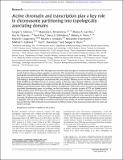Active chromatin and transcription play a key role in chromosome partitioning into topologically associating domains
Author(s)
Ulianov, Sergey V.; Khrameeva, Ekaterina E.; Gavrilov, Alexey A.; Flyamer, Ilya M.; Kos, Pavel; Mikhaleva, Elena A.; Penin, Aleksey A.; Logacheva, Maria D.; Chertovich, Alexander; Gelfand, Mikhail S.; Shevelyov, Yuri Y.; Razin, Sergey V.; Imakaev, Maksim Viktorovich; ... Show more Show less
DownloadUlianov-2015-Active chromatin and.pdf (3.562Mb)
PUBLISHER_CC
Publisher with Creative Commons License
Creative Commons Attribution
Terms of use
Metadata
Show full item recordAbstract
Recent advances enabled by the Hi-C technique have unraveled many principles of chromosomal folding that were subsequently linked to disease and gene regulation. In particular, Hi-C revealed that chromosomes of animals are organized into topologically associating domains (TADs), evolutionary conserved compact chromatin domains that influence gene expression. Mechanisms that underlie partitioning of the genome into TADs remain poorly understood. To explore principles of TAD folding in Drosophila melanogaster, we performed Hi-C and poly(A)+ RNA-seq in four cell lines of various origins (S2, Kc167, DmBG3-c2, and OSC). Contrary to previous studies, we find that regions between TADs (i.e., the inter-TADs and TAD boundaries) in Drosophila are only weakly enriched with the insulator protein dCTCF, while another insulator protein Su(Hw) is preferentially present within TADs. However, Drosophila inter-TADs harbor active chromatin and constitutively transcribed (housekeeping) genes. Accordingly, we find that binding of insulator proteins dCTCF and Su(Hw) predicts TAD boundaries much worse than active chromatin marks do. Interestingly, inter-TADs correspond to decompacted inter-bands of polytene chromosomes, whereas TADs mostly correspond to densely packed bands. Collectively, our results suggest that TADs are condensed chromatin domains depleted in active chromatin marks, separated by regions of active chromatin. We propose the mechanism of TAD self-assembly based on the ability of nucleosomes from inactive chromatin to aggregate, and lack of this ability in acetylated nucleosomal arrays. Finally, we test this hypothesis by polymer simulations and find that TAD partitioning may be explained by different modes of inter-nucleosomal interactions for active and inactive chromatin.
Date issued
2015-10Department
Massachusetts Institute of Technology. Department of PhysicsJournal
Genome Research
Publisher
Cold Spring Harbor Laboratory Press
Citation
Ulianov, Sergey V.; Khrameeva, Ekaterina E.; Gavrilov, Alexey A.; Flyamer, Ilya M.; Kos, Pavel; Mikhaleva, Elena A.; Penin, Aleksey A. et al. "Active chromatin and transcription play a key role in chromosome partitioning into topologically associating domains." Genome Research 26 (October 2015): 70-84 © 2016 Ulianov et al
Version: Final published version
ISSN
1088-9051
1549-5469